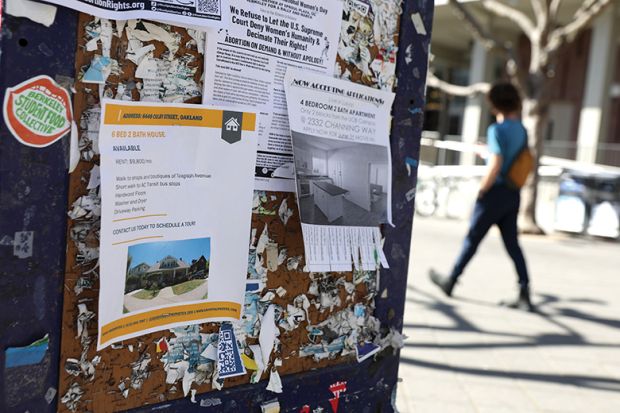The high-stakes battle over housing around the University of California, Berkeley is dramatising for US higher education the growing reality of rent as an overlooked obstacle to greater campus and societal equity.
The showdown in Berkeley – where a court ruling sharply limiting enrolment at one of the world’s top public institutions required an emergency state legislative override – has been cast as largely pitting a few wealthy city residents against some boisterous student tenants.
More broadly, however, experts say the US is suffering from a chronic shortage of housing that hurts all low-income Americans, especially those trying to attend almost any type of college or university.
The resulting expectation is that US policymakers and academic institutions, even as they direct more financial and logistical aid towards the neediest students, will not succeed in many locations without somehow substantially improving housing options.
“This is a widespread issue, not just in California but across the US,” said Bryce McKibben, senior director of policy and advocacy at the Hope Center for College, Community and Justice at Temple University.
As with most things, Covid has made social divisions in both housing and education even worse. Overall enrolment at US universities fell by nearly 3 per cent last autumn, after a 2.5 per cent decline the previous year. Elite institutions, meanwhile, have seen their applications surge. Berkeley had a record 128,000 bids for this autumn’s intake, a 13 per cent jump over last year’s record. The University of California, Los Angeles hit nearly 150,000, the most applications in the country.
The patterns are similar at elite privates. Applications to Harvard University rose by 8 per cent to nearly 43,000, a fourth straight record year. Yale University hit a record 50,000.
But US campuses, for the most part, are not miraculously finding large tracts of land at affordable rates within short walking or easy commuting distances, said Dave Borsos, vice-president for capital markets at the National Multifamily Housing Council, the chief US association of apartment construction companies.
That great supply-demand imbalance naturally drives up housing prices, Mr Borsos said. The effects are even worse, he said, for low-income students, because government tax credits and other programmes to subsidise housing construction are typically designed for needy families. “There’s really not an equivalent on the student housing side,” he said.
The government subsidies that are aimed at students are also failing to keep up. The main federal aid for low-income students, the Pell grant, was worth three-quarters of the cost of studying at a four-year public institution when the programme was created in the 1970s. It now covers about 30 per cent. The Biden administration has proposed doubling its value, but Congress has allowed only far more limited increases.
A survey last year by Mr McKibben’s research institute, covering nearly 200,000 students across 200 campuses in 42 states, reflected those realities. It found that 43 per cent of four-year students struggled to pay for housing. Among those at two-year institutions, more than half were rated as housing insecure.
California – marked by a relatively high cost of living and steady population growth – has some particularly jarring examples. They include Long Beach City College, a two-year institution just south of Los Angeles that has equipped a car park with bathrooms, power outlets and overnight security guards to help some of its dozens of students who sleep in their cars.
The University of California, Santa Barbara is a couple of hours up the Pacific coast, tucked between the mountains and the shoreline, on a campus of scenic bliss and little room to expand. Like Berkeley, it faces state pressure to enrol more students and local pressure to limit community impact. Its answer – requiring a $200 million (£150 million) private donation and drawing ridicule over the promise of windowless bedrooms – is Munger Hall, a planned 11-storey structure with nearly 5,000 students that will be the world’s largest dormitory.
Even among those students who manage to attend an elite institution, the housing challenges of higher education may exacerbate rather than heal the divisions of human circumstance. Just two blocks west of Berkeley’s main campus – one of the growing number of US institutions that no longer guarantee housing even for first-year undergraduates – sits a private complex offering students who can afford its $3,500-a-month apartments “a myriad of contemporary and stylish interior features, including private bedrooms, spacious steel appliances” and more, as well as “a view overlooking San Francisco Bay, the San Francisco skyline, and the Bay and Golden Gate bridges”.
Its owner, Landmark Properties, based in Georgia, is a member of Mr Borsos’ association. He said he would be concerned if universities could not serve a broad range of society and bring together students of all backgrounds, but that market conditions would dictate what developments were possible.
“They’re going to build if there is a demand,” Mr Borsos said of his members. “If they could financially make it work, knowing that there’s a demand for a lower price-point product, they would also do that.”
后记
Print headline: US push to help poor wilts on home front




